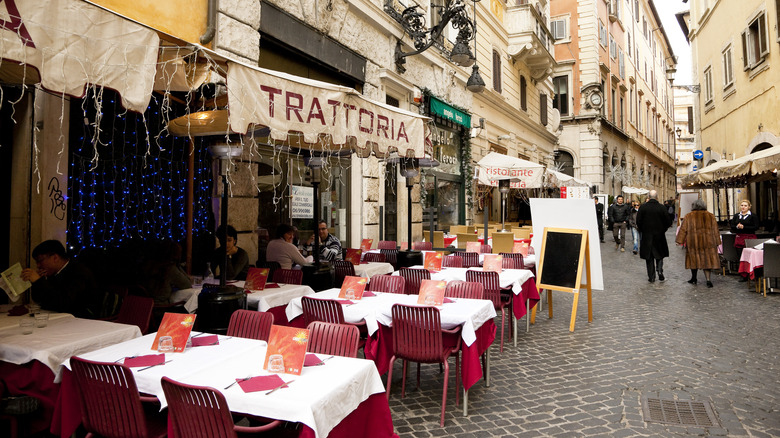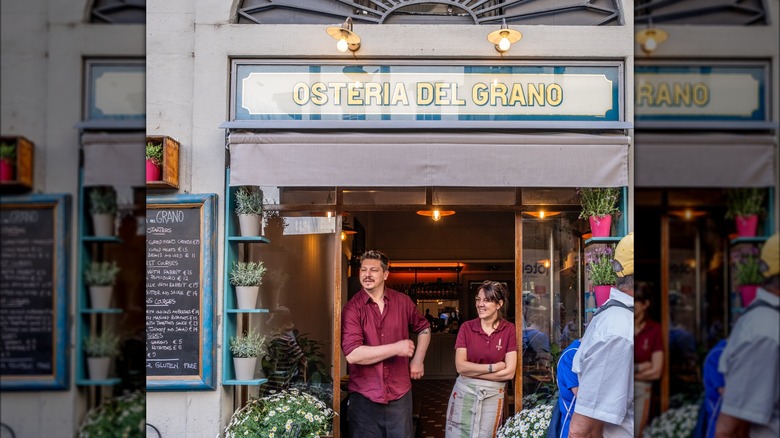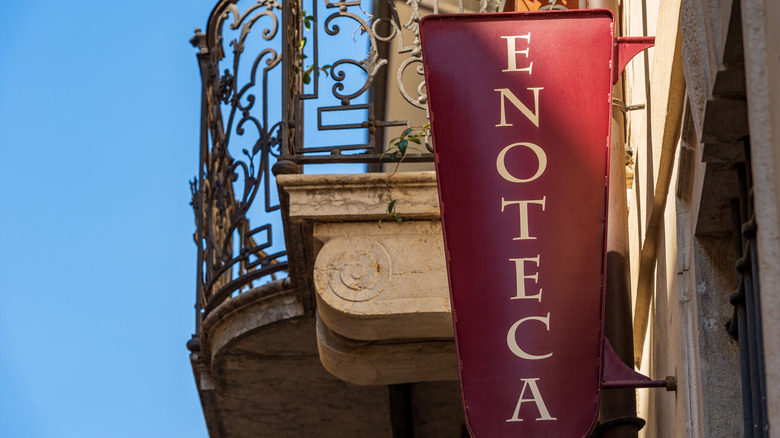When In Italy, You Should Know The Difference Between An Osteria And Trattoria
When planning a trip to Italy, most people intend to take in the world-famous landscapes, art, architecture, and, the most essential element, the food. Highlighted by copious amounts of pasta, pizza, wine, cheese, salumi (not to be confused with salami), and olive oil, Italian cuisine is celebrated for its focus on seasonality, local ingredients, and simple elegance, all of which you can experience at the country's countless eateries. Unlike in America, where any place serving food is considered a "restaurant," in Italy, there are several titles for dining locations, such as osterias and trattorias.
The unassuming tourist might be thrown off by these titles, so it's helpful to know exactly what differentiates them. First of all, you can enjoy an excellent meal at both. The types of dishes they serve often overlap, serving things like soups, vegetable dishes, pasta, meats, and desserts.
But an osteria tends to be a more casual type of place, one where you're likely to see a chalkboard menu that changes from day to day, with many osterias offering a fixed menu for a set price. Seating may also be communal at osterias. Meanwhile, trattorias are usually run by families, with everyone from Nonna in the kitchen making homemade pasta to the bambini tagging along next to their parents, helping to hand out flatware.
Both osterias and trattorias offer regional specialties at fairly reasonable prices without stuffy atmospheres. So long as the location is reputable, you can enjoy an excellent Italian meal at either.
Trattorias are a tad more formal than osterias
Osterias in Italy have come quite a long way since their inception. Originally, they were inns that offered shelter for weary travelers. They served wine from large casks, but not food. In fact, guests often brought their own food inside where they ate, drank, socialized, and could stay overnight in a room.
As time progressed, more and more osterias began to offer simple foods, more snack-like than full-fledged meals. While they now often include two- or three-course meals, the casual atmosphere remains. Menus reflect what is in season and what looks good at the market on any given day, so if you enjoy a meal at an osteria on one particular day and return the next, you may find the place has a completely different set of offerings. Occasionally, there will be no written menu at all; instead, your server will explain what's being whipped up in the kitchen that day.
Trattorias are popular among locals and tourists because they often exude a friendly, welcoming ambiance. Families that run trattorias get to know their regular guests, and, between the familiarity and the good food, these eateries sometimes get crowded to the point where you may need to make a reservation to obtain a table. Trattorias could be described as a bit more formal than an osteria, but not as much as an Italian ristorante. That being said, they are still considered casual places to dine.
Ristorantes, enotecas, and bars
Italian ristorantes are considered the most formal places to eat in the country and will usually have a full staff including hosts, sommeliers, printed menus, and professional chefs and cooks. But even some fine dining establishments in the country are distancing themselves from the title of "ristorante." Take Massimo Bottura's Osteria Francescana, for example. Be assured, there are no chalkboard menus in this highly celebrated, three Michelin-starred establishment. It's very much considered fine dining despite its name.
Enotecas are lesser-known places that actually serve much more wine than they do food. An enoteca celebrates a region's particular wines and allows guests to taste them before they make a purchase. You'll often find snacks like bread, bites of cheese, or even light appetizers like crostini to enjoy between sips of vino.
You'll probably notice a lot of "bars" in Italy, which are very different from bars in America. While you can order wine, beer, and afternoon cocktails — like the ubiquitous Aperol Spritz – at these establishments, bars are very popular places for people of all ages to stop in during the morning for an espresso and pastry. Italians will also visit them throughout the afternoon for more coffee, an affogato (the drink that doubles as a dessert), or a small sandwich.



